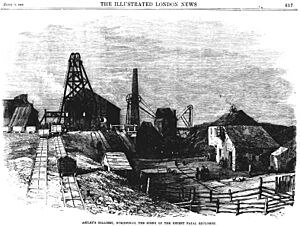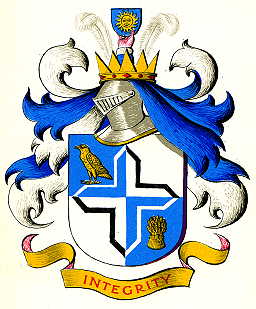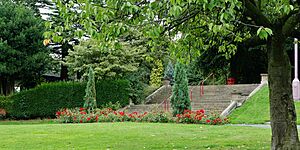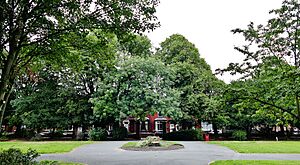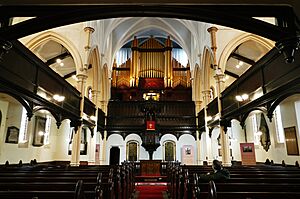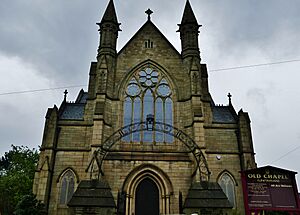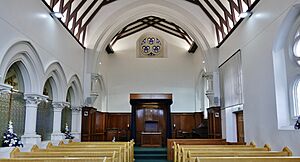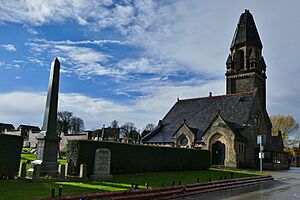Dukinfield facts for kids
Quick facts for kids Dukinfield |
|
|---|---|
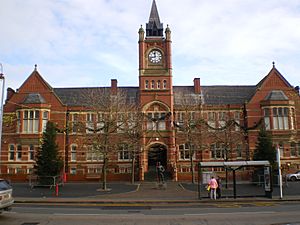 Dukinfield Town Hall |
|
| Population | 19,306 (2011 Census) |
| OS grid reference | SJ945975 |
| • London | 160 mi (257 km) SSE |
| Metropolitan borough | |
| Metropolitan county | |
| Region | |
| Country | England |
| Sovereign state | United Kingdom |
| Post town | DUKINFIELD |
| Postcode district | SK16 |
| Dialling code | 0161 |
| Police | Greater Manchester |
| Fire | Greater Manchester |
| Ambulance | North West |
| EU Parliament | North West England |
| UK Parliament |
|
Dukinfield is a town in Tameside, Greater Manchester, England. It sits on the south side of the River Tame, right across from Ashton-under-Lyne. It's about 6.3 miles (10.1 km) east of Manchester. In 2011, about 19,306 people lived there.
Dukinfield is part of the historic county of Cheshire. The town grew a lot during the Industrial Revolution. This was a time when new machines and factories changed how things were made. Dukinfield became important for coal mining and making cotton.
Contents
- History of Dukinfield
- How Dukinfield is Governed
- Geography and Geology
- Population and People
- Economy and Jobs
- Important Places (Landmarks)
- Getting Around (Transport)
- Learning and Schools (Education)
- News and Entertainment (Media)
- Places of Worship (Religion)
- Sports in Dukinfield
- Public Services
- Famous People from Dukinfield
- Twin Town
- Images for kids
- See also
History of Dukinfield
Early Times
The oldest signs of people living around Dukinfield are four flint tools. These tools are from the late Neolithic (New Stone Age) or early Bronze Age. They were found where Dukinfield Hall used to be, suggesting people lived there long ago. We don't find much more evidence until the Roman period. A Roman coin from the 3rd century was also found in the town.
The name Dukinfield means "Raven of the Field." It comes from old English words.
Early records show that Dukinfield was part of the area controlled by Dunham Massey. A family called "De Dokenfeld" took over around 1190. They lived at Dukinfield Old Hall, a large house with a moat. This house was first built after the Norman Conquest and rebuilt in Tudor times. The Dukinfield family lived there until the 1700s.
During the English Civil War, Colonel Robert Duckenfield from Dukinfield Hall was a famous leader in the New Model Army. His son, also named Robert Dukinfield, was given the special title of Baronet in 1665.
The Dukinfield family owned the land for 500 years. Then, in 1767, the wife of Sir William Dukinfield Daniel married John Astley. When she died, John Astley inherited the estate. He was an artist and architect. He designed and built Dukinfield Lodge as a new home for the family. It was on a hill overlooking the River Tame.
His son, Francis Dukinfield Astley, became the new owner in 1787. Then, his son, Francis Dukinfield Palmer Astley, took over in 1825.
The Industrial Revolution in Dukinfield
The growth of factories, especially cotton factories, changed Dukinfield a lot. This fast growth meant that the old fields and meadows were replaced by buildings. Before 1794, two cotton mills were built. By 1825, there were seven! The industry kept growing, and by the late 1800s, there were 14 spinning mills. The biggest mills were built in the 1890s. They were tall brick buildings with big windows, fancy towers, and tall chimneys. Some of these were Tower, Tame Valley, River, Park Road, and Queen Mills. Most of these cotton mills are gone now, but some have been saved and turned into apartments.
Coal mining was also a huge part of Dukinfield's history. Coal was found deep underground. One mine entrance was on Birch Lane, where All Saints' Catholic College is now. Another was near the border with Ashton-under-Lyne. Francis Dukinfield Astley started opening coal mines around 1820. After he died in 1825, his son, Francis Dukinfield Palmer Astley, continued to develop two important mines: Dukinfield Colliery and Astley Deep Pit. Both of these mines had terrible explosions that killed many workers.
- Dukinfield Colliery (also called Lakes Pit or Victoria Colliery) was owned by Astley's Dukinfield Colliery Company. It had two shafts, one of which was 1,020 feet deep. On June 4, 1867, 38 men and boys died from suffocation after an explosion. This was caused by a broken safety lamp and poor management.
- Astley Deep Pit, located off King's Street, was also started by Astley. By 1874, Benjamin Ashton owned it. The main shaft was 2,058 feet deep. At one time, this was said to be the deepest coal mine in the world! On April 14, 1874, an underground gas explosion killed 54 men. The pit closed in 1901. The land was later used to build houses.
Samuel Robinson was a Unitarian (a type of Christian), factory owner, and a smart person. He started the village library in 1833. People called him the "best supporter of education in the area" before he died in 1884. Daniel Adamson was an engineer who became the first chairman of the Manchester Ship Canal Company. He had a factory in Dukinfield that made boilers. He died in 1890. The Adamson Military Band, a music group, is named after him and is based in Dukinfield.
Dukinfield and nearby towns were places where people protested a lot in the 1800s. For a short time, the area was a center for Chartism. This was a movement that wanted everyone to have the right to vote. A Chartist leader, Reverend Joseph Rayner Stephens, is buried in St John's Churchyard.
How Dukinfield is Governed
In the Middle Ages, Dukinfield was part of the parish of Stockport. In 1866, it became its own civil parish. Then, in 1894, the parts of Dukinfield not already in Stalybridge became an urban district in the county of Cheshire.
In 1899, Dukinfield was given the special status of a municipal borough. This meant it had its own local government. In 1936, it grew bigger by adding part of the Matley civil parish.
However, in 1974, the Municipal Borough of Dukinfield was removed. Its land was combined into the new Metropolitan Borough of Tameside, which is part of Greater Manchester.
Today, Dukinfield has 6 of the 57 seats on the Tameside Metropolitan Borough Council. These seats are divided into two areas: Dukinfield and Dukinfield Stalybridge. Currently, Dukinfield has five councillors from the Labour Party and one from the Conservative Party.
Andrew Gwynne is Dukinfield's Member of Parliament (MP). He was first elected in 2005 to represent the Denton and Reddish area, which includes Dukinfield.
Geography and Geology
 |
Audenshaw | Ashton-under-Lyne | Stalybridge |  |
| Guide Bridge | ||||
| Newton Wood | Hyde | Newton |
Dukinfield is about 159 miles (256 km) north-northwest of London. Its northern and western edges are marked by the River Tame.
The town is located where the flat Cheshire Plain meets the Pennines hills. Dukinfield is the first town you reach as you go up the hill. Dukinfield Park is about a quarter of a mile from the town hall. Because the land rises steeply, the park has different levels and is over 90 feet higher at the top. The hill then flattens a bit before rising steeply again to the east, where the library is.
The town hall is also at the bottom of this hill. Astley Street goes steeply up its shorter southern side, climbing about 120 feet to the top of the ridge. The soil in the area is mostly clay, with some river deposits.
Underneath Dukinfield are layers of coal, which are part of the middle coal measures. These layers run north to south under Tameside. Dukinfield is built on what was once a huge ancient lake or swamp. This is why coal is found here. The layers of shale and coal are stacked on top of each other, only 20 or 30 feet thick. The coal layers slope downwards at about a 20-degree angle. They stretch eight or nine miles from the base of the hill out under the plain. These coal deposits are known as the Dukinfield Marine Band.
Dukinfield had several mines, and Astley Deep Pit had the best coal. Dukinfield coal was known to be excellent for heating and making steam.
Population and People
| Dukinfield compared | |||
|---|---|---|---|
| 2001 UK census | Dukinfield | Tameside | England |
| Total population | 18,885 | 213,043 | 49,138,831 |
| White | 97.3% | 94.6% | 90.9% |
| Asian | 1.7% | 4.0% | 4.6% |
| Black | 0.1% | 0.3% | 2.3% |
In 2001, Dukinfield had a population of 18,885 people. There were about 9922 people per square mile. For every 100 females, there were about 94 males. Of adults over 16, about 29.1% had never been married, 42.1% were married, and 9.4% were divorced.
Dukinfield had 8,072 homes. In these homes, 31.2% were people living alone, 36.8% were married couples, 9.9% were couples living together but not married, and 10.5% were single parents with their children. About 35.1% of adults aged 16–74 did not have any school qualifications.
In 2001, most people in Dukinfield (79.0%) said they were Christian. A small number were Hindu (0.9%), Muslim (0.8%), or Buddhist (0.1%). About 12.2% said they had no religion.
How the Population Changed
| Population growth in Dukinfield since 1801 | ||||||||||||||||||||
|---|---|---|---|---|---|---|---|---|---|---|---|---|---|---|---|---|---|---|---|---|
| Year | 1801 | 1811 | 1821 | 1831 | 1841 | 1851 | 1861 | 1871 | 1881 | 1891 | 1901 | 1911 | 1921 | 1931 | 1939 | 1951 | 1961 | 1971 | 2001 | 2011 |
| Population | 1,737 | 3,053 | 5,096 | 14,681 | 22,394 | 26,418 | 15,024 | 14,085 | 16,942 | 17,385 | 18,929 | 19,422 | 19,509 | 19,311 | 17,749 | 18,451 | 17,316 | 17,302 | 17,917 | 22,938 |
| Source: A Vision of Britain through Time | ||||||||||||||||||||
Dukinfield started as a small village south of Ashton-under-Lyne. There was open land to the south and east. The town grew quickly during the cotton and coal industries. Its population boomed.
Even after these industries declined in the 1900s, Dukinfield kept its population steady. This is partly because it's on a main road from Stockport to Ashton-under-Lyne. It's also easy to travel from Dukinfield to Manchester for work.
Economy and Jobs
| Dukinfield compared | |||
|---|---|---|---|
| 2001 UK Census | Dukinfield | Tameside | England |
| Population of working age | 13,621 | 151,445 | 35,532,091 |
| Full-time employment | 45.6% | 43.5% | 40.8% |
| Part-time employment | 11.8% | 11.9% | 11.8% |
| Self employed | 5.9% | 6.5% | 8.3% |
| Unemployed | 3.2% | 3.3% | 3.3% |
| Retired | 13.1% | 13.3% | 13.5% |
In 2001, most people in Dukinfield aged 16–74 worked in certain industries. About 24.4% worked in manufacturing (making things). 19.3% worked in retail and wholesale (shops and selling goods). 10.0% worked in health and social work (hospitals, care homes). Other jobs included property, construction, transport, education, and finance.
Compared to the rest of England, Dukinfield had more people working in manufacturing. It had fewer people working in farming, government jobs, and education.
Important Places (Landmarks)
Dukinfield Town Hall was built in the late 1890s and opened in 1901. Money for it came from when Dukinfield became a Borough. Dukinfield Park was also created at the same time and cost the same amount. There's an 80-foot difference in height between the lower King Street side and the back of the park. On a clear day, you can stand at the top of the steps and see Manchester city centre.
Old Hall Chapel is a very old church. It claims to be the first independent church in the 1600s. It was built in the late 1400s. Sadly, part of it is ruined because a fire in the 1970s destroyed much of its roof.
Getting Around (Transport)
Transport for Greater Manchester helps organize public transport in the area.
Buses
Bus services are run by companies like Stagecoach Manchester and First Group. Here are some routes that serve Dukinfield:
- 220: Goes from Manchester city centre to Stalybridge.
- 221: Goes from Dukinfield to Manchester city centre.
- 330: Goes from Ashton-under-Lyne to Stockport, usually every ten minutes.
- 335: Goes from Ashton-under-Lyne to Denton.
- 343: Goes from Hyde to Oldham.
- 345: Goes from Ashton-under-Lyne to Denton.
- 346: Goes from Ashton-under-Lyne to Gee Cross.
- 389: Goes from Ashton-under-Lyne to Yew Tree.
Trains
Dukinfield Central railway station closed in 1959. Now, the closest train stations are Stalybridge, Hyde North, and Ashton-under-Lyne.
Trams
The modern tram system, Manchester Metrolink, currently ends at nearby Ashton-under-Lyne. From there, you can connect to the city centre. An older tram network used to run through Dukinfield from 1904 to 1945.
Air Travel
Manchester Airport is about 8 miles (13 km) from Dukinfield. You can easily get there by road or public transport.
Canals
Dukinfield Junction is where three canals meet: the Peak Forest, Ashton, and Huddersfield Narrow Canals.
Learning and Schools (Education)
Dukinfield has many primary schools and nurseries for children aged 5 to 11.
There are secondary schools in the town. For further education (like college after secondary school), the closest places are Tameside College in Ashton-under-Lyne or Hyde.
All Saints Catholic College offers education for 16- to 18-year-olds. Since 1998, they have had a special building for their sixth form students.
News and Entertainment (Media)
Local news and TV shows come from BBC North West and ITV Granada.
Local radio stations include BBC Radio Manchester (95.1 FM), Capital Manchester and Lancashire (102.0 FM), and Tameside Radio (103.6 FM), which is a community station based in the town.
The local newspaper is the Tameside Reporter, published every Thursday.
Places of Worship (Religion)
The Moravian Church started its work in Dukinfield in 1751. They built a Moravian Settlement where Moravian Close is now. Their burial ground, called God's Acre, is still there. The main church for the area, St. John the Evangelist, was built between 1840 and 1841. Another church, St Mark's, was started in 1847.
Dukinfield has several Protestant and Catholic churches. The closest mosque is in Ashton-under-Lyne.
Sports in Dukinfield
Dukinfield Cricket Club started in 1870. They play in the Lancashire County League.
Dukinfield Rugby Union Football Club was founded in 1880, making it one of the oldest rugby teams from Cheshire. They play their home games at Blocksages Playing Fields.
Dukinfield Town AFC, a football club, was founded in 1948. They play at Blocksage's Playing Fields, next to the rugby club. They won the Manchester Senior Cup in 1971.
Dukinfield Central Bowling Club plays in the Tameside Mens Crown Green Bowling League. They have won the premier division title many times, including in 2011, 2012, 2016, 2017, 2018, and 2019.
Public Services
Dukinfield's town hall offers some local services, like a police station and a registry office for official documents. Most of the main local government work is done at the Tameside Council headquarters in Ashton-under-Lyne.
Dukinfield has a public library in Concord Way, which is part of a small shopping area. There is also a Morrisons supermarket in town.
The town has a park with gardens, a play area, and places for fun activities. The old public swimming pool is now a fitness centre with an indoor running track. It's part of the sports facilities offered by Tameside Sport. There are also two full-size sports pitches used by the town's rugby and football teams.
Rayner Stephens High School has artificial sports pitches that the public can use outside of school hours.
Famous People from Dukinfield
Sports Stars
- Norman 'Buddy' Oldfield (1911-1996) was a first-class cricketer born in Dukinfield. He played for Lancashire and Northamptonshire, and for England in 1939.
- Tony Brooks (1932-2022) was a Formula One racing driver in the 1950s. He won six Grand Prix races.
- Tony Durose was born in Dukinfield and played first-class cricket for Northamptonshire.
Actors and Actresses
- Kathy Staff (1928–2008)
- Shirley Stelfox (1941–2015)
- John Normington (1937–2007)
Musicians
- John Lever, drummer for the band The Chameleons.
- Ronnie Hazlehurst, a famous composer who wrote music for TV and radio shows.
- Kevin Parrott, a record producer and musician. He produced the song "Matchstalk Men and Matchstalk Cats and Dogs".
Politicians
- Carole James, a Canadian politician who used to be the Leader of the Opposition in British Columbia.
Scientists
- Peter Daszak, a zoologist (someone who studies animals).
- Dennis Walsh, an astronomer (someone who studies space).
Business People
- Roderick Jones (1877–1962), who was the head of Reuters (a big news agency), was born in Dukinfield.
- Wayne Griffiths, who is the President of SEAT (a car company).
Twin Town
Dukinfield has a twin town called Champagnole in Jura, France. They became twin towns in 1958.
Images for kids
See also
 In Spanish: Dukinfield para niños
In Spanish: Dukinfield para niños



